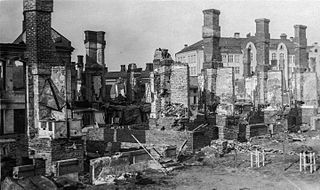| |||||||||||||||||
| |||||||||||||||||
| |||||||||||||||||
The California gubernatorial election, 1918 was held on November 5, 1918.
| |||||||||||||||||
| |||||||||||||||||
| |||||||||||||||||
The California gubernatorial election, 1918 was held on November 5, 1918.
| Party | Candidate | Votes | % | ± | |
|---|---|---|---|---|---|
| Republican | William D. Stephens (incumbent) | 387,547 | 56.28 | ||
| Independent | Theodore Arlington Bell | 251,189 | 36.48 | ||
| Socialist | Henry H. Roser | 29,003 | 4.21 | ||
| Republican | James Rolph (write-in) | 20,605 | 2.99 | ||
| Total votes | 688,344 | 100.0% | |||
| Republican hold | Swing | ||||

Czechoslovakia, or Czecho-Slovakia, was a sovereign state in Central Europe that existed from October 1918, when it declared its independence from the Austro-Hungarian Empire, until its peaceful dissolution into the Czech Republic and Slovakia on 1 January 1993.

The Finnish Civil War was a conflict for the leadership and control of Finland during the country's transition from a Grand Duchy of the Russian Empire to an independent state. The clashes took place in the context of the national, political, and social turmoil caused by World War I in Europe. The civil war was fought between the Reds, led by a section of the Social Democratic Party, and the Whites, conducted by the conservative-based Senate and the German Imperial Army. The paramilitary Red Guards, composed of industrial and agrarian workers, controlled the cities and industrial centres of southern Finland. The paramilitary White Guards, composed of farmers, along with middle-class and upper-class social strata, controlled rural central and northern Finland.

The German Empire, also known as Imperial Germany, was the German nation state that existed from the unification of Germany in 1871 until the abdication of Kaiser Wilhelm II in 1918.

The Russian Civil War was a multi-party war in the former Russian Empire immediately after the two Russian Revolutions of 1917, as many factions vied to determine Russia's political future. The two largest combatant groups were the Red Army, fighting for the Bolshevik form of socialism led by Vladimir Lenin, and the loosely allied forces known as the White Army, which included diverse interests favoring political monarchism, economic capitalism and alternative forms of socialism, each with democratic and antidemocratic variants. In addition, rival militant socialists and nonideological Green armies fought against both the Bolsheviks and the Whites. Eight foreign nations intervened against the Red Army, notably the former Allied military forces from the World War and the pro-German armies. The Red Army eventually defeated the White Armed Forces of South Russia in Ukraine and the army led by Admiral Aleksandr Kolchak to the east in Siberia in 1919. The remains of the White forces commanded by Pyotr Nikolayevich Wrangel were beaten in Crimea and evacuated in late 1920. Lesser battles of the war continued on the periphery for two more years, and minor skirmishes with the remnants of the White forces in the Far East continued well into 1923. The war ended in 1923 in the sense that Bolshevik communist control of the newly formed Soviet Union was now assured, although armed national resistance in Central Asia was not completely crushed until 1934. There were an estimated 7,000,000–12,000,000 casualties during the war, mostly civilians. The Russian Civil War has been described by some as the greatest national catastrophe that Europe had yet seen.

The Treaty of Brest-Litovsk was a peace treaty signed on March 3, 1918 between the new Bolshevik government of Russia and the Central Powers, that ended Russia's participation in World War I. The treaty was signed at German-controlled Brest-Litovsk, after two months of negotiations. The treaty was agreed upon by the Russians to stop further invasion. According to the treaty, Soviet Russia defaulted on all of Imperial Russia's commitments to the Allies and eleven nations became independent in Eastern Europe and western Asia.

The 1918 influenza pandemic was an unusually deadly influenza pandemic, the first of the two pandemics involving H1N1 influenza virus. It infected 500 million people around the world, including people on remote Pacific islands and in the Arctic, and resulted in the deaths of 50 to 100 million, making it one of the deadliest natural disasters in human history.

The Browning Automatic Rifle (BAR) is a family of American automatic rifles and machine guns used by the United States and numerous other countries during the 20th century. The primary variant of the BAR series was the M1918, chambered for the .30-06 Springfield rifle cartridge and designed by John Browning in 1917 for the American Expeditionary Forces in Europe as a replacement for the French-made Chauchat and M1909 Benét–Mercié machine guns that US forces had previously been issued.

The 1918 United Kingdom general election was called immediately after the Armistice with Germany which ended the First World War, and was held on Saturday 14 December 1918. The governing coalition, under Prime Minister David Lloyd George, sent letters of endorsement to candidates who supported the coalition government. These were nicknamed "Coalition Coupons", and led to the election being known as the "coupon election". The result was a massive landslide in favour of the coalition, comprising primarily the Conservatives and Coalition Liberals, with massive losses for Liberals who were not endorsed. Nearly all the Liberal M.P.s without coupons were defeated, although party leader H.H. Asquith managed to return to Parliament in a by-election.

The German Revolution or November Revolution was a civil conflict in the German Empire at the end of the First World War that resulted in the replacement of the German federal constitutional monarchy with a democratic parliamentary republic that later became known as the Weimar Republic. The revolutionary period lasted from November 1918 until the adoption in August 1919 of the Weimar Constitution.

The Habsburg Monarchy – also Habsburg Empire, Austrian Monarchy or Danube Monarchy – is an unofficial umbrella term among historians for the countries and provinces that were ruled by the junior Austrian branch of the House of Habsburg between 1526 and 1780 and then by the successor branch of Habsburg-Lorraine until 1918. The Monarchy was a typical composite state composed of territories within and outside the Holy Roman Empire, united only in the person of the monarch. The dynastic capital was Vienna, except from 1583 to 1611, when it was moved to Prague. From 1804 to 1867 the Habsburg Monarchy was formally unified as the Austrian Empire, and from 1867 to 1918 as the Austro-Hungarian Empire.

The Hundred Days Offensive was an Allied offensive which ended the First World War. Beginning with the Battle of Amiens on the Western Front, the Allies pushed Central Powers back after their gains from the Spring Offensive. The Germans eventually retreated to the Hindenburg Line, culminating in the Armistice of 11 November 1918. The term "Hundred Days Offensive" does not refer to a battle or strategy, but rather the rapid series of Allied victories against which the German armies had no reply.

The Allied intervention was a multi-national military expedition launched during the Russian Civil War in 1918. The stated goals were to help the Czechoslovak Legion, to secure supplies of munitions and armaments in Russian ports, and to re-establish the Eastern Front. Overthrow of the new Bolshevik regime was an additional, covert motivation.

The Allies of World War I or Entente Powers is the term commonly used for the coalition that opposed the Central Powers of Germany, Austria-Hungary, the Ottoman Empire and Bulgaria during the First World War (1914–1918).

The United States Senate elections of 1918 were held November 5, 1918, which was the midpoint of Woodrow Wilson's second term as President of the United States. The Republican Party gained control with a slim 2-seat majority after picking up a net six seats. The change in control was particularly important, as it meant that the Republicans were in a position to deny entry of the United States into the League of Nations. US participation in this new international institution was the centerpiece of Wilson's post-war foreign policy.

World War I, also known as the First World War or the Great War, was a global war originating in Europe that lasted from 28 July 1914 to 11 November 1918. Contemporaneously described as "the war to end all wars", it led to the mobilisation of more than 70 million military personnel, including 60 million Europeans, making it one of the largest wars in history. It is also one of the deadliest conflicts in history, with an estimated nine million combatants and seven million civilian deaths as a direct result of the war, while resulting genocides and the 1918 influenza pandemic caused another 50 to 100 million deaths worldwide.

Deities of Slavic religion, arranged in cosmological and functional groups, are inherited through mythology and folklore. Both in the earliest Slavic religion and in modern Slavic Native Faith's theology and cosmology, gods are arranged as a hierarchy of powers begotten by the supreme God of the universe, Rod, known as Deivos in the earliest Slavic religion. According to Helmold's Chronica Slavorum, "obeying the duties assigned to them, [the deities] have sprung from his [the supreme God's] blood and enjoy distinction in proportion to their nearness to the god of the gods". The general Slavic term for "god" or "deity" is бог bog, whose original meaning is both "wealth" and its "giver". The term is related to Sanskrit bhaga and Avestan baga. Some Slavic gods are worshipped to this day in folk religion, especially in countrysides, despite longtime Christianisation of Slavic lands, apart from the relatively recent phenomenon of organised Slavic Native Faith (Rodnovery).
The air commanders of World War I were army or navy officers who came to command air services during the first major conflict in which air power played a significant role.

The Russian Soviet Federative Socialist Republic, previously known as the Russian Soviet Republic and the Russian Socialist Federative Soviet Republic, as well as being unofficially known as the Russian Federation, Soviet Russia, or simply Russia, was an independent state from 1917 to 1922, and afterwards the largest, most populous and most economically developed of the 15 Soviet socialist republics of the Soviet Union (USSR) from 1922 to 1991, then a sovereign part of the Soviet Union with priority of Russian laws over Union-level legislation in 1990 and 1991, during the last two years of the existence of the USSR. The Russian Republic comprised sixteen smaller constituent units of autonomous republics, five autonomous oblasts, ten autonomous okrugs, six krais and forty oblasts. Russians formed the largest ethnic group. The capital of the Russian SFSR was Moscow and the other major urban centers included Leningrad, Novosibirsk, Yekaterinburg, Nizhny Novgorod and Samara.
| This California elections-related article is a stub. You can help Wikipedia by expanding it. |